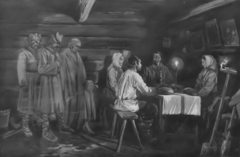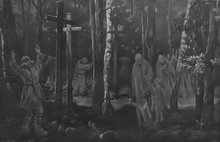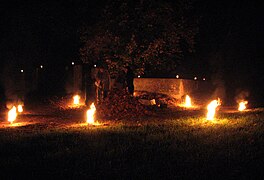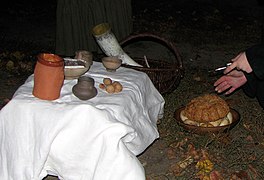| Dziady | |
|---|---|
 "Dziady, pradziady, przyjdzcie do nas!" Depiction of dziady ritual in Belarus, Stanisław Bagieński. "Dziady, pradziady, przyjdzcie do nas!" Depiction of dziady ritual in Belarus, Stanisław Bagieński. | |
| Observed by | Poles, Belarusians, Ukrainians, Lithuanians (nowadays rodnovers and Christians in christianised form) |
| Type | Pagan, cultural |
| Significance | Communion of the living with the dead |
| Celebrations | Offering food to ancestors |
| Date | Between the last day of April and the first day of May or around the spring equinox (spring dziady) Secondly, between the last day of October and the first day of November or around the autumnal equinox (autumn dziady) |
| Frequency | Twice a year |
| Related to | Zaduszki, Radonitsa, Vėlinės, Allhallowtide |
Dziady (lit. "grandfathers, eldfathers", sometimes translated as Forefathers' Eve) is a term in Slavic folklore for the spirits of the ancestors and a collection of pre-Christian rites, rituals and customs that were dedicated to them. The essence of these rituals was the "communion of the living with the dead", namely, the establishment of relationships with the souls of the ancestors, periodically returning to their headquarters from the times of their lives. The aim of the ritual activities was to win the favor of the deceased, who were considered to be caretakers in the sphere of fertility. The name "dziady" was used in particular dialects mainly in Poland, Belarus, Polesia, Russia, and Ukraine (sometimes also in border areas, e.g. Podlachia, Smoleńsk Oblast, Aukštaitija), but under different other names (pomynky, przewody, radonitsa, zaduszki) there were very similar ritual practices, common among Slavs and Balts, and also in many European and even non-European cultures.
Etymology
In the context of the pagan holiday of the dead, the most popular name is "dziady". The word "dziad" comes from the Proto-Slavic word *dědъ (pl. *dědi) meaning primarily "father of the father, father of the mother", "an old man with an honorable position in the family", "ancestor" and "old man". Second meaning is "spirit, demon" (compare Polish dziadzi (adjective) considered a euphemism from diabli (adjective of "devil"), Kashubian. dżôd "evil spirit, which threaten children, domestic spirit", Czech děd "domestic deity", Russian died (dialect) „chort, domestic spirit", Pskov, Smolensk: diedý (pl.) "ritual to honor the dead", Ukrainian didý (pl.) "shadows in the corners of the room (at dusk)" (colloquially), "a day of remembrance of the dead, All Souls' Day", Belarusian dzied, dziadý (pl.) "ritual to honor the dead, a day of remembrance of the dead, All Souls' Day"). Related words are associated with the second meaning, i.e. Proto-Slavic *dedъka: Russian diedka (dialect) "devil, chort, domestic spirit", diedia "devil" (e.g. lesnoj diedia "forest devil"), Proto-Slavic *dedъko: Russian diedko "chort, domestic spirit", Slovak dedkovia (pl.) "domestic deities, souls of the ancestors, guardian spirits of the house", Ukrainian didko "chort, devil, impure/evil power" or Proto-Slavic *dědъkъ: Lower Sorbian źědki (pl.) "gnomes", Czech dedek "domestic deity".
Dates
| This list is incomplete; you can help by adding missing items. (October 2022) |
In the Slavic tradition, depending on the region, the feast of the deceased was celebrated at least twice a year. The main dziady were the so-called spring dziady and autumn dziady:
- Spring dziady were celebrated around 1 and 2 May (depending on lunar phase)
- Autumn dziady were celebrated on the night from October 31 to November 1, also known as All Saints Day, which was a preparation for the autumn day of the dead, celebrated around November 2.(depending on lunar phase)
Rituals of the dziady

Within the framework of grandfather's rituals, the souls coming to "this world" had to be hosted in order to secure their favour and at the same time help them to achieve peace in the hereafter. The basic ritual form was feeding and watering of souls (e.g. honey, groats, eggs, forge and vodka) during special feasts prepared in houses or cemeteries (directly on graves). A characteristic feature of these feasts was that the people who ate them dropped or poured some of their food and drinks on the table, floor or grave for the souls of the deceased. In some areas, however, the ancestors also had to be given the opportunity to bathe (a sauna was prepared for this) and warm up. This last condition was fulfilled by lighting fires, whose function is sometimes explained differently. They were supposed to light the way for wandering souls so that they would not get lost and could spend the night with their loved ones. The remnants of this custom are contemporary candles lit on graves. However, fire – especially the one kindled on crossroads – could also have had another meaning. The idea was to prevent demons (souls of people who died suddenly, suicides, drowning, etc.) from being born, which were believed to have been extremely active during this period. In some regions of Poland, e.g. Podhale, in the place of someone's violent death, every passer-by was obliged to throw a sprig at the stake, which was then burned every year.
A special role in suffragette rites was played by beggars, who in many regions were also called dziady. This coincidence of names was not accidental, because in the folklore of itinerants, the beggars-dziady were seen as mediation figures and connectors with the "other world". Therefore, people asked them to pray for the souls of their deceased ancestors, offering food (sometimes special ritual bread prepared for the occasion) or cash donations in return. The passing on of food to beggars as part of soul rituals is sometimes interpreted as a form of feeding the souls of ancestors, which is confirmed by the fact that in some areas they were given their favorite dishes of the deceased.
Main article: Dziady (wandering beggars)
During this holiday, there were numerous prohibitions concerning the performance of various works and activities that could disturb or even threaten the peace of the souls on earth. The following were prohibited: loud behaviour at the table and suddenly getting up (which could frighten souls), cleaning from the table after supper (so that souls could feed), pouring water after washing dishes through the window (so as not to pour over the souls staying there) smoking in the oven (this way – as it was believed – souls would sometimes get home), sewing, weaving or spinning (so as not to sew or tie up a soul that could not return to "that world") or working on flax.
Rite in literature
Main article: Dziady (poem)The folk ritual of the dziady became an inspiration for the Adam Mickiewicz's Dziady, the central motif of which are the scenes of summoning souls during the village congregation, taking place in the abandoned chapel at the cemetery. The ritual is presided over by the Guślarz (Koźlarz, Huslar), who preaches ritual formulas and evokes the souls of the dead in purgatory. They are to tell them what they need to achieve salvation and to eat the food they have carried for them.
Ethnological and literary studies clearly show that in Mickiewicz's work we deal with stylization. The author took numerous elements from Belarusian folklore, processed them artistically and created an original image. In fact, the rituals of the dziady took place in christian times, either in houses, or in cemeteries by the graves of their ancestors, or in places connected archetypically (and often also locally) with former centers of worship – on hills, under sacred trees, in places considered sacred (sometimes actually by chapels, which were often built on former places of pagan worship). Mickiewicz's references to terms such as "purgatory" and "salvation" are the result of combining pagan and Christian customs.
Contemporary celebration

To this day, in some regions of eastern Poland, Belarus, Ukraine and part of Russia, it is cultivated to carry on the graves of the dead a symbolic meal in clay pots. The majority of Slavic neo-pagan and rodnover movements also cultivate the dziady. Every year in Krakow, a traditional Rękawka [pl] is held, directly related to the ancient custom of spring ancestors' holiday.

In Belarus, dziady began to gain in importance in the late 1980s and were particularly important for Belarusian Catholics, for whom this day became a symbol of memory of the victims of the communist regime. On October 30, 1988, the first mass gathering was organized, not by the authorities but by activists, to commemorate the victims in 20th century Belarus. The authorities of that time, which did not like it, dispersed the assembly with the help of the militsiya. The dziady ceased to be a day off in 1996, when the holiday began to be associated with the democratic opposition. Nowadays, hundreds of thousands of Belarusians are taking leave on demand to honor their ancestors on November 1 and 2. In 2017, the President of the Episcopal Conference of Belarus, Tadeusz Kondrusiewicz, said that the dziady should be a day off from work, instead of the October Revolution on November 7. He also supported the Internet petition for granting the status of a day off from work to grandfathers, which has now collected over 2500 signatures.
Dziady and Christianity
Christianity, on the one hand, fought against pagan rituals, successfully banning them, and on the other hand, it tried to adapt some of them in an attempt to christianize them. In the case of the dziady, both the Catholic and the Orthodox Church tried to marginalize and then eliminate pagan festivals by introducing into their squares (at the same or similar moments of the annual cycle) Christian festivals and practices (respectively, the counselor subots and the suffragettes). A different strategy was adopted in the Uniate Church, which obliged the priests to go with the rural population to their dziady and pray the Angelus, the Hail Mary and other christian prayers. In some regions, the Uniate priests celebrated special processions at the cemeteries, during which they consecrated individual graves and collected food and money left on them.
Gallery
-
 Mazovian temple, NPC during the celebration of the dziady in 2009
Mazovian temple, NPC during the celebration of the dziady in 2009
-
 Preparations for the celebration of the dziady – NPC, 2008, Pęcice
Preparations for the celebration of the dziady – NPC, 2008, Pęcice
-
 Preparation of the obiata during the dziady
Preparation of the obiata during the dziady
See also
Notes
- Belarusian: Дзяды; Russian: Деды, romanized: Dedy; Ukrainian: Діди, romanized: Didy; Polish: Dziady; Lithuanian: Ilgės
References
- Деды / Виноградова Л. Н., Толстая С. М. // Славянские древности: Этнолингвистический словарь : в 5 т. / под общ. ред. Н. И. Толстого; Институт славяноведения РАН. — М. : Межд. отношения, 1999. — Т. 2: Д (Давать) — К (Крошки). — С. 45. — ISBN 5-7133-0982-7.
- ^ Szyjewski 2003, p. 210.
- Fischer 1923, p. 15.
- Kolankiewicz 1999, p. 6.
- ^ Pietkiewicz 1931, p. 78-80, Z. 3.
- ^ Biegeleisen 1929, p. 343-352.
- Grochowski 2009, p. 34-37.
- ^ Fischer 1923, p. 22.
- Krzyżanowski & Wojciechowski 1958, p. 316-320.
- Keios Solutions. "Święta". Rodzimy Kościół Polski. Retrieved 2020-10-29.
- "Dziady - Rodzima Wiara - oficjalna strona". rodzimawiara.org.pl. Retrieved 2020-10-29.
- "Białorusini chcą znów obchodzić Dziady. O nowej historii słowiańskiego święta" (in Polish). naviny.belsat.eu. Retrieved 2020-10-29.
- "Abp Kondrusiewicz: Zamiast rocznic rewolucji – Dziady i Wszystkich Świętych" (in Polish). naviny.belsat.eu. Retrieved 2020-10-29.
- "Зрабіць Дзяды непрацоўным днём – даць магчымасць ушанаваць продкаў!" (in Belarusian). Зрабіць Дзяды непрацоўным днём – даць магчымасць ушанаваць продкаў! |. Archived from the original on 2020-11-02. Retrieved 2020-10-29.
- Swianiewiczowa 1961, p. 141-142.
- Pigoń 1966, p. 70-71.
Bibliography
- Fischer, Adam (1923). Święto umarłych. Lwów: Muzeum im. Dzieduszyckich.
- Pietkiewicz, Czesław (1931). "Umarli w wierzeniach Białorusinów". Pamiętnik Warszawski. 2–3.
- Biegeleisen, Henryk (1929). U kolebki, przed ołtarzem, nad mogiłą. Lwów: Instytut Stauropigjański.
- Szyjewski, Andrzej (2003). Religia Słowian. Kraków: Wydawnictwo WAM. ISBN 83-7318-205-5.
- Krzyżanowski, Julian; Wojciechowski, Ryszard (1958). "„Dziady" kowieńsko-wileńskie". In Wantowska, Maria (ed.). Ludowość u Mickiewicza: praca zbiorowa. Warszawa: State Publishing Institute PIW.
- Swianiewiczowa, Olimpia (1961). "Dziady białoruskie". Rocznik Polskiego Towarzystwa Naukowego na Obczyźnie. 21.
- Swianiewiczowa, Olimpia (2018). Charytoniuk-Michiej, Grażyna (ed.). Interpretacja Dziadów Mickiewiczowskich na podstawie skarbca kultury białoruskiej. Toruń: Muzeum Etnograficzne im. Marii Znamierowskiej-Prüfferowej w Toruniu. ISBN 9788361891215.
- Kowalska-Lewicka, Anna (1994). "Zmarli są wśród nas. O obcowaniu zmarłych z żyjącymi". Rocznik Muzeum Etnograficznego W Krakowie. 9.
- Kolankiewicz, Leszek (1999). Dziady. Teatr święta zmarłych. Gdańsk: Słowo/Obraz Terytoria. ISBN 8387316393.
- Grochowski, Piotr (2009). Dziady. Rzecz o wędrownych żebrakach i ich pieśniach. Toruń: The Nicolaus Copernicus University Press. ISBN 978-83-231-2383-5.
- Pigoń, Stanisław (1966). "Wołyńskie przewody. Wiosenne święto zmarłych". Drzewiej i wczoraj: wśród zagadnień kultury i literatury. Wydawnictwo Literackie.
External links
| Polish folk customs and traditions | |
|---|---|
| Winter | Konik • Koza • Turoń • Podłaźniczka • Gromnica • Jemioła • Ścięcie śmierci • Podkoziołek • Popielcowe klocki • Wkupne do bab • Zapusty • Ostatki • Przebierańce • Comber • Herody • Kolęda |
| Spring | Marzanna • Zielone Świątki • Gregorianki • Hanging of Judas • Pucheroki • Święconka • Śmigus-dyngus • Emaus fair • Turki • Dziady śmigustne • Śmiergust • Siuda Baba • Kurek dyngusowy • Pisanki • Walatka • Easter palm • Jezusek Palmowy • Funeral of żur and a herring • Roduś • Rękawka • Żandary • Siwki • Maypole • Fat Thursday • Gorzkie żale |
| Summer | Noc Kupały • Sobótka • Wyzwolenie kosiarza • Oborywanie przepiórki • Ścinanie kani • Zażynki |
| Autumn | Dożynki • Dziady • Zaduszki • Katarzynki • Andrzejki |
| Attire • Traditional music • Folk dances • Folk beliefs | |
| Halloween | |||||
|---|---|---|---|---|---|
| Main topics | |||||
| Traditions | |||||
| Food | |||||
| Events | |||||
| Media | |||||
| Related events |
| ||||
| Other events | |||||